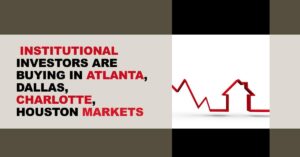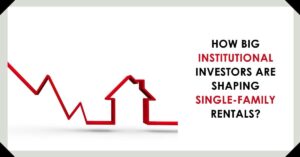The US housing market continues to evolve, with a growing presence of institutional investors in the single-family rental space. As foreclosure rates have declined, these large-scale investors have adopted new strategies to acquire properties. This trend is particularly noticeable in the Sunbelt region, where cities like Atlanta, Dallas, Charlotte, and Houston are experiencing a significant rise in investor-owned rentals. Is this good or bad for renters & homebuyers? Let's find out.
Big Investors Set Their Sights on Sunbelt Rentals
According to the U.S. Government Accountability Office (GAO), institutional investors are defined as those owning 1,000 or more properties. By June 2022, an estimated 32 investors met this criteria, collectively holding nearly 450,000 single-family homes nationwide. This translates to roughly 3% of all rental properties in the U.S. While the overall numbers might seem small, their impact is concentrated in specific areas.
One of the key findings of the study is the geographic clustering of these investments. Institutional investors tend to favor high-growth regions with a booming job market and strong rental demand. The Sunbelt, a term encompassing the southeastern and south-central United States, perfectly fits this description.
Following the 2008 financial crisis, this region saw a surge in foreclosure activity, leading to a pool of potentially undervalued properties. Additionally, the Sunbelt's generally newer housing stock offered investors opportunities for price recovery.
Atlanta, Dallas, Charlotte, and Houston emerged as top targets for these investors. As of 2022, these cities boasted some of the highest concentrations of investor-owned single-family rentals. This trend can be attributed to several factors.
Firstly, economies of scale come into play – by focusing on specific metropolitan areas, investors can streamline operations and reduce costs associated with property management and maintenance. Secondly, a dense concentration of rentals allows investors to achieve similar efficiencies enjoyed in multi-family housing investments.
The GAO study also highlights the preference of institutional investors for moderate- and higher-income neighborhoods. However, the specific neighborhoods targeted can vary depending on the investor's strategy.
For example, a study of Atlanta's rental market revealed contrasting approaches by different investors. One investor focused on neighborhoods with a high percentage of Asian and Hispanic residents, while another concentrated on areas with a predominantly non-Hispanic Black population.
This trend underscores the complexity of the investor landscape. While certain property characteristics undoubtedly influence purchasing decisions, the choice of neighborhoods appears to be more nuanced and may differ based on the investor's specific goals and investment strategies.
Impact on Renters, Market, and Homeownership
The growing presence of institutional investors in the Sunbelt's single-family rental market presents a unique situation with potential benefits and drawbacks. Let's analyze the impact on various stakeholders.
Impact on Renters:
- Increased Competition: A surge in investor-owned rentals can lead to heightened competition among renters, potentially driving up rental prices. This could be particularly challenging for low- and moderate-income renters who may find it increasingly difficult to secure affordable housing options.
- Standardized Management: Institutional investors often manage their properties professionally, which can translate to consistent and efficient maintenance services. Renters can expect timely repairs and a more professional approach to tenancy management.
- Potential for Limited Choice: A large number of investor-owned properties can limit the variety of rental options available. Renters seeking unique or character homes might find themselves with fewer choices in a market dominated by standardized investment properties.
Impact on the Housing Market:
- Potential for Increased Stability: Institutional investors often hold their properties for extended periods, contributing to stability in the housing market. This can be particularly beneficial in areas prone to volatile market fluctuations.
- Impact on Homeownership Rates: A rise in investor ownership can make it more challenging for aspiring homeowners to compete, especially when bidding against cash-backed investors. This could potentially lead to a decrease in overall homeownership rates.
- Potential for Revitalization: Investor activity can revitalize neighborhoods by renovating older properties and bringing vacant units back into the rental market. This can have a positive impact on the overall aesthetics and property values in the area.
Considerations for Homebuyers:
- Strategic Bidding: Understanding the investor presence in your target area is crucial. When competing against investors, it may be necessary to consider offering above-asking price or presenting a stronger financial profile.
- Alternative Financing Options: Exploring programs like FHA loans or down payment assistance initiatives can help bridge the gap for aspiring homeowners facing stiff competition from cash buyers.
- Focus on Long-Term Ownership: If you plan to stay in the home for a longer duration, purchasing a property might be a viable option despite the initial challenges. Owning a home offers long-term benefits like equity building and potential appreciation in value.
Looking Forward – Policy, Trends, and Recommendations
The influx of institutional investors into the Sunbelt rental market is a complex issue with far-reaching implications. Understanding potential policy measures, emerging trends, and formulating recommendations can help renters, homeowners, and policymakers navigate this evolving landscape.
Policy Measures:
- Fair Housing Regulations: Ensuring fair housing regulations are upheld is crucial to prevent discrimination against renters based on race, ethnicity, or source of income.
- Investor Registration and Transparency: Increased transparency regarding investor activity can help policymakers better understand the market dynamics and formulate informed regulations.
- Incentives for Homeownership: Programs that support homeownership, such as down payment assistance or tax breaks for first-time buyers, can help level the playing field for aspiring homeowners competing with cash investors.
Emerging Trends:
- Technology and Automation: The use of technology for property management, tenant screening, and rent collection is likely to increase, potentially impacting the overall rental experience.
- Focus on Sustainability: As environmental concerns gain prominence, investor focus might shift towards energy-efficient properties or developments with sustainable features.
- Rise of Build-to-Rent Communities: The build-to-rent model, where investors construct communities specifically for rentals, may become more prevalent, catering to the growing demand for high-quality rental housing.
Recommendations:
For Renters:
- Shop Around and Compare: Despite the rise of investor ownership, independent landlords are still present in the market. Carefully compare rental options to find the best fit in terms of price, location, and amenities.
- Understand Lease Agreements: Be sure to thoroughly understand the terms of your lease agreement, particularly regarding rent increases, maintenance policies, and pet restrictions.
- Maintain a Positive Rental History: Paying rent on time and maintaining the property in good condition can strengthen your position as a renter and potentially open doors to better rental opportunities in the future.
For Homebuyers:
- Get Pre-Approved for a Mortgage: Securing pre-approval demonstrates your financial readiness to potential sellers and can give you an edge over competing offers, particularly from investors.
- Consider Working with a Buyer's Agent: A qualified buyer's agent can provide invaluable guidance throughout the homebuying process, helping you navigate the competitive market and secure the best possible deal.
- Stay Informed: Staying updated on market trends and investor activity in your target area allows you to make informed decisions and adjust your strategies accordingly.
By understanding the complexities of the Sunbelt rental market and its evolving dynamics, both renters and aspiring homeowners can make informed choices.
Policymakers also have a role to play in ensuring fair housing practices and a healthy balance between investor activity and homeowner opportunities. As the Sunbelt rental market continues to transform, staying informed and adapting to these changes will be key to success for all stakeholders involved.
ALSO READ:
Housing Market Predictions for Next 5 Years (2024-2028)
Housing Market Predictions for the Next 2 Years
Housing Market Predictions 2024: Will Real Estate Crash?
Housing Market Predictions: 8 of Next 10 Years Poised for Gains
Housing Market Cooling Faster Than Expected?
Is the Housing Market Shifting? Key Trends to Watch (April Report)
Housing Market Trends: How BIG Investors Are Shaping Single-Family Rentals


